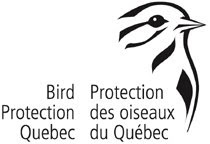As some of you know, I will be giving a course in March on Breeding Bird Atlas Techniques and their Application to Day-to-Day Birding. This is part of the BPQ's Winter Bird Courses. For those of you who are planning on taking the course, I have a small, class asignment for you so that the class can get a 'flying' start on the subject matter.
A number of species in the boreal forest do the unexpected. That is, they begin their breeding period in mid-winter. In fact, the breeding season has already started for the two crossbill species. The ability of these two species to raise a family in the dead of a Canadian winter is truly amazing. If you find yourself in the conifer forests north of Montreal, keep an eye open and an ear cocked for displaying Red and White-winged Crossbills (Bec-croisé des sapins; Bec-croisé
bifascié).
In a month or so, another Boreal Forest resident, the Gray Jay (Mésangeai du Canada), will begin nest building and egg laying. Calls and other indications that the nesting season has started such as seeing a Gray Jay carrying nesting material should be noted.
Lastly, a more widely distributed species, the Great Horned Owl (Grand-duc d'Amérique) is also entering its nesting season. If you're out-and-about in the evening over the next month, listen for their calls.
Displays, territorial calls/songs, and carrying nesting material are all indications of breeding and will be the sort of things participants in the upcoming Quebec Breeding Bird Atlas will be asked to look for.
So, for those of you taking the course, your task is simple. Make it a point of looking and listening for these four species when you are in suitable areas over the next six weeks. At the start of the course we will pool and discuss our observations. - Lance
Wednesday, January 27, 2010
Subscribe to:
Post Comments (Atom)





No comments:
Post a Comment